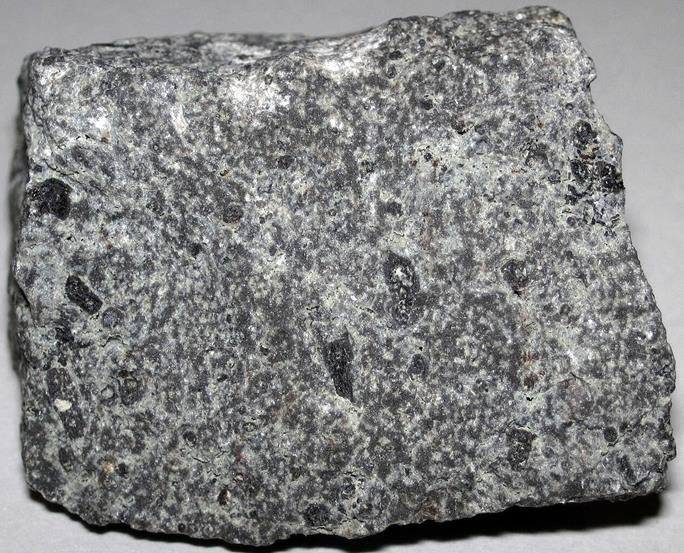Andesite is an intermediate volcanic or extrusive igneous rock. Intermediate rocks are moderate in silica (52-63 wt.%), mafic, and felsic minerals.
Mafic minerals are dark-colored rock-forming minerals rich in iron and magnesium. In contrast, felsic minerals are high in light-colored elements like silicon, oxygen, potassium, aluminum, and sodium.
On the other hand, extrusive or volcanic means this rock forms on the Earth’s surface where cooling is relatively fast. This fast-cooling history results in a fine-grained or aphanitic texture.
On the Earth’s surface, andesite is the next most common rock after basalt. Also, it occurs in Martian meteorites.

Description
Andesite is a hard, moderately dense rock with typical densities of 2.4-2.8g/cm3 and a Mohs hardness scale of 6-7.
Its color is usually light to medium gray on a fresh surface. However, some can have shades of orange, blue, greenish-black, or greenish-gray with a few blackish.
Weathered surfaces will have a greenish, reddish, brownish-red, or brownish tinge. Mineral alteration causes this color change.
As already hinted, the texture of andesite is aphanitic or fine-grained. Therefore, you cannot see or distinguish its minerals from the naked eye.
However, many will have a porphyritic texture with large minerals called phenocrysts in a fine-grained matrix or groundmass. Also, a few may show vesicular, trachytic, ophitic, subophitic, and amygdaloidal textures.
Chemical composition
The Andesite composition is intermediate, with 57-63% silica and less than 7% alkali oxides (Na2O and K2O). It is moderate in iron and calcium oxide and relatively high in aluminum.
In total Alkali-Silica (TAS) classification, the composition of this mesocratic rock lies between basaltic andesite and dacite. It lies beneath trachyandesite, which is higher in alkali oxides.
Mineral composition
Andesite has mostly sodium-rich plagioclase, pyroxene, and less amounts of hornblende. Also, it has minor alkali feldspar and quartz, with biotite and muscovite less common.
Accessory minerals include ilmenite, magnetite, garnet, apatite, and zircon.
The sodium-rich plagioclase is mostly andesine but can range from anorthite to oligoclase, while pyroxenes are mostly augite, pigeonite, and enstatite. Usually, enstatite replaces any olivine present.
On the QAPF classification, andesite is a fine-grained volcanic rock with 1) less than 20% quartz, 2) less than 10% feldspathoids by volume with plagioclase at least 65% of total feldspar.
Andesite is the extrusive or volcanic equivalent of diorite, a plutonic or intrusive igneous. They both have the same chemical composition and mineralogy. However, diorite has a coarse-grained texture and forms from the slow cooling of magma deep inside the Earth’s crust.
Andesite rock formation
Andesite rocks form when evolved or differentiated magma cools quickly on the Earth’s surface. Rapid cooling favors nucleation over crystal growth as it causes supercooling. Thus, the rock will form tiny crystals invisible to the naked eye.
These rocks form mostly as surface deposits, including tuff, breccia, conglomerates, scoria, lava flow, etc., depending on how the magma erupts. Very little amount occurs as plugs or dikes.
The evolved andesitic magmas, i.e., magmas that form andesite, form from fractional crystallization of basaltic magmas. It can happen with the assimilation of crystal rocks.
Also, magma mixing and partial melting (anatexis) of subcrustal rocks or metasomatized mantle can form andesitic magmas.
Where are andesite rocks found?
Andesite rocks occur mostly on island and continental volcanic arcs. Volcanic or magmatic arcs are chains of volcanoes that form above subduction zones. This is where an older, denser oceanic crust descends beneath either continental or younger, less dense oceanic crust.
Examples of continental arcs where andesite occurs are the Andes in South America, where it gets its name, and the Cascade Volcanic arc in the US and Canada. Others are the Central America Volcanic Arc and the Aleutian Range in the US.
On the other hand, island arcs include the Aleutian Islands and Mariana in the US, Japan, Indonesia, Tonga, Antilles, and the Philippine Islands.
Most of these volcanic arcs occur on the infamous Pacific Ring of Fire.
Besides volcanic arcs, this rock also occurs in continental hotspots and rifts and seldomly in mid-ocean ridges.
What are the uses of andesite?
Andesite is a common hard and durable rock whose uses include:
- Making aggregate for building and construction projects like roads, bridges, houses, airports, seaports, etc. However, its high silica content makes it not good for concrete.
- Crushed andesite rocks can also make landscaping stones, ripraps to control erosion, gravel pathways, patios, etc.
- It serves as a masonry and architectural or dimensional stone for making rough texture pavers and flooring bricks or tiles being rough in texture.
- Making sculptures, statues, and other decorative ornaments.
- Porphyritic andesite varieties may occur with copper deposits. Also, some have andesine, a valued and pricey gemstone.
Frequently Asked Questions (FAQs)
It refers to an imaginary line parallel to the Pacific Basin’s deep oceanic trenches and subduction zones, separating basaltic rocks from partly submerged andesitic rocks in the Central Pacific Basin.
Porphyritic andesite has large crystals or phenocrysts of plagioclase, hornblende, or pyroxenes in a fine-grained groundmass of mostly plagioclase with smaller amounts of magnetite, pyroxenes, and other accessory minerals and sometimes glass.
